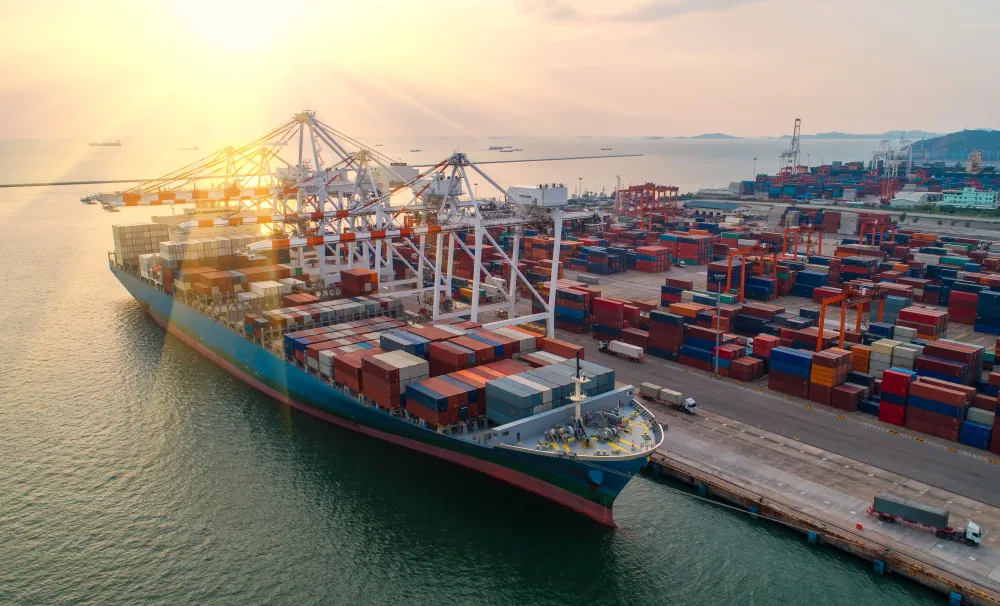
Indian Economy
A Quick Look into India's Agricultural Exports
India is one of the world’s largest producers and exporters of agricultural products. Agriculture plays a vital role in India’s economy, contributing to about 17% of the gross domestic product (GDP) and employing more than 50% of the workforce.
By India Index
4 min read
India is one of the world’s largest producers and exporters of agricultural products. Agriculture plays a vital role in India’s economy, contributing to about 17% of the gross domestic product (GDP) and employing more than 50% of the workforce.
Agriculture also supports rural development, poverty alleviation, food security, and environmental sustainability. In this article, we will explore the major agriculture exports of India, the challenges they face, and the future trends and opportunities in this sector.
Major Agricultural Exports
India is a global agricultural exporter, shipping diverse products like rice, spices, tea, coffee, oilseeds, fruits, vegetables, marine items, meat, dairy, and flowers. Its advantage lies in varied agro-climates, vast arable land, affordable labor, and strong domestic demand.
Quality, variety, and cultural significance drive global interest. In 2020-21, India's agricultural exports totaled $41.25 billion, mainly to the USA, China, Bangladesh, UAE, and Vietnam.
Leading exports included basmati rice, buffalo meat, non-basmati rice, spices, and sugar, reinforcing India's pivotal role in international agricultural trade.
Challenges in Agricultural Exports
Despite its potential and achievements, India’s agricultural exports face several challenges that limit its growth and competitiveness. Some of these challenges are:
India's agricultural exports must adhere to strict quality and SPS regulations of importing nations, covering pesticides, contaminants, GMOs, etc. Certification and traceability are crucial.
India's agricultural sector faces yield and quality threats from pests and diseases like fruit flies, nematodes, and fungal infections. Integrated pest management, biocontrol agents, and resistant varieties are employed to combat these challenges.
India's agricultural supply chain inefficiencies lead to high post-harvest losses due to inadequate storage, transportation, handling, and intermediaries. Investing in modern technologies like cold chain management, sorting machines, and packaging can mitigate these losses.
Processed and Value-Added Exports
To address India's agricultural export challenges, boosting the proportion of processed and value-added products in its exports holds promise. Processed items encompass preserved fruits, juices, sauces, and snacks, while value-added products involve organics, GI-labeled items, and ethnic foods, all with distinct features augmenting their value.
Compared to raw goods, these offer extended shelf life, higher value, reduced transport costs, broader market reach, and strong consumer preference. This approach curtails post-harvest losses, bolsters farm income, generates jobs, and diversifies exports.
India's resource abundance, diverse cuisine, heritage, and skilled labor favor processed exports. Yet, at 15%, India's share lags the 25% global average due to insufficient processing infrastructure, high taxes, limited awareness, and international competition.
Organic and Sustainable Exports
A rising global trend is the demand for organic and sustainable agri-products. Organic goods are produced without synthetic fertilizers, pesticides, GMOs, or chemicals. Sustainable agri-products conserve resources, cut emissions, and boost well-being.
These products benefit producers, consumers, and the environment. They offer superior nutrition, taste, and safety to consumers, along with better prices, lower costs, and resilience for producers.
They also reduce environmental impact, enhance biodiversity, and promote soil health. India's potential in this market is vast due to its climate, small farmers, traditions, and growing demand. However, challenges include certification, costs, awareness, trust, and global competition.
Technology and Modern Farming Practices
Tech and modern practices boost India's agri-export quality and competitiveness. Tech involves tools, machines, and software enhancing efficiency. Modern practices use science to improve yields. Some of the examples are:
- Precision farming: Precision farming is a technique that uses sensors, GPS, drones, satellites, etc., to collect and analyze data on soil, crops, weather, pests, etc., and provide customized inputs and recommendations to farmers.
- Precision farming can help optimize resource use, reduce input costs, increase crop quality, and enhance traceability.
- Drip irrigation: Drip irrigation is a technique that delivers water and nutrients directly to the roots of the plants through pipes or tubes with small holes or emitters.
- Drip irrigation can help save water, increase fertilizer efficiency, produce weed growth, and improve crop quality.
- Mechanization: Mechanization is the use of machines or equipment to perform various agricultural tasks such as land preparation, sowing, harvesting, threshing, etc.
- Mechanization can help in reducing drudgery, increasing labor productivity, reducing post-harvest losses, and improving crop quality.
India's strides in tech and modern farming are notable, but room for enhancement exists. Constraints like awareness, access, affordability, availability, and adaptability persist.
Trade Agreements and Market Access
Trade deals and market entry drive India's agri-export growth. Deals are formal terms between countries, while market access allows unrestricted sales abroad.
Trade agreements and market access can benefit India’s agricultural exports by:
- Reducing or eliminating tariffs, quotas, subsidies, or other trade barriers that affect the competitiveness of Indian agri-products in foreign markets.
- Providing preferential access or treatment to Indian agri-products in foreign markets by granting lower tariffs, higher quotas, longer periods of protection, etc.
- Enhancing cooperation and collaboration between India and its trading partners on various issues such as SPS measures, technical barriers to trade (TBT), intellectual property rights (IPR), dispute settlement, etc.
- Creating new opportunities and markets for Indian agri-products by exploring new regions or sectors that have high potential or demand for Indian agri-products.
India has engaged in numerous trade pacts with regions like ASEAN, SAARC, EU, USA, and Japan, covering agricultural goods and services. Despite this, barriers persist in key markets due to non-tariff obstacles, trade disputes, and protectionist measures.
Future Trends in Agricultural Exports
The global market for agricultural products is constantly evolving and changing due to various factors such as shifting consumer preferences, technological innovations, environmental concerns, etc. Some of the future trends that can affect India’s agricultural exports are:
- Consumers are becoming more health conscious and aware of the nutritional value and safety of the food they consume. They are looking for products that are organic, natural, fortified, functional, etc., that can enhance their health and well-being.
- Exotic, rare, and specialty items like dragon fruit, kiwi, quinoa, and moringa are in demand. Consumers value distinct flavors, sources, colors, and nutrition, driving higher prices for these unique products.
- Eco-conscious consumers seek environmentally friendly products produced with minimal resource use, reduced emissions, and biodiversity preservation. They prioritize eco-friendly packaging, labeling, and certifications showcasing environmental credentials.
- Consumers are looking for products that cater to their specific needs, wants, and desires. They are also looking for products that can be customized or personalized according to their preferences such as flavor, size, shape, color, etc.
These trends present new opportunities and challenges for India’s agricultural exports. India has to adapt to these changing consumer preferences and demands by developing new products, improving quality standards, adopting innovative technologies, and enhancing marketing strategies.
Government Initiatives and Support
The government of India has taken several initiatives and measures to support and promote India’s agricultural exports. Some of these initiatives and measures are:
- Agricultural and Processed Food Products Export Development Authority (APEDA): APEDA is an autonomous organization under the Ministry of Commerce and Industry which is responsible for developing and promoting India’s agricultural exports. APEDA provides various services such as registration, certification, quality assurance, market development, financial assistance, etc., to exporters of agricultural products.
- Krishi Udaan Scheme: Krishi Udaan Scheme is a scheme launched by the Ministry of Civil Aviation in collaboration with the Ministry of Agriculture and Farmers Welfare to provide air transportation of agricultural products from remote areas to domestic and international markets. The theme is to reduce transportation costs and time, improve shelf life and quality, and increase farmers’ income.
- Agriculture Export Policy (AEP): AEP is a policy announced by the government of India in 2018 to provide a stable and predictable policy regime for agricultural exports. This policy aims to double India’s agricultural exports from USD 30 billion in 2017-18 to USD 60 billion by 2022-23.
- This policy has two components: strategic and operational. The strategic component includes vision, goals, objectives, and action plans for agricultural exports. The operational component includes focuses on infrastructure development, quality standards, market intelligence, research and development, etc.
Conclusion
India's agricultural produce has enormous export potential and a solid demand globally. India offers a range of diverse agro-produces, ample arable land, low labor costs, and strong domestic demand.
However, challenges like compliance management and supply chain inefficiencies hamper export growth. Solutions involve value-added exports, eco-friendly products, tech adoption, trade pacts, and stakeholder collaboration. These efforts can bolster India's economy, employment, farmer income, and global reputation.
By striving for sustainable growth and becoming an agri-export leader, India can secure a prominent position in the global agricultural market while benefiting its economy and society.
💡 Want to use automation for your teams?
Was this article helpful? 💡


